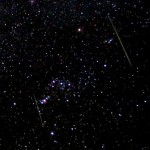The first meteor shower of 2017 is the annual Quadrantid meteor shower. The Quadrantids are a reliable shower, producing 60-120 ZHR, one to two meteors per minute. The Quadrantids are named for the obsolete constellation Quadrans Muralis, now part of the constellation Boötes.

This year’s peak is calculated for January 3rd at 14:00UT, this would be January 3rd at 04:00HST, well timed for observers in the islands. For northern observers the radiant is circumpolar, thus the shower is observable all night long. Given our 20° latitude here in Hawaii the radiant does not rise until 01:30HST, thus observations must wait until well into the morning hours. As this perfectly corresponds with the peak this looks to be an ideal meteor shower for island observers. Further, a first quarter moon will have long set leaving a perfectly dark morning sky for observing meteors.
A first quarter Moon on January 5 creates favourable viewing conditions for the predicted Quadrantid maximum on January 3. For many northern hemisphere sites, the shower’s radiant is circumpolar, in northern Boötes, from where it first attains a useful elevation after local mid-night, steadily improving through till dawn. The 14h UT timing for the peak is favourable for observers in the west of North America. Observers in the north of Asia will find the radiant close to the horizon in their evening skies. The λ⊙ = 283.15◦ maximum timing is based on the best-observed return of the shower ever analysed (IMO data from 1992), and has been confirmed by optical and radio results in most years since. Typically, the peak is short-lived, so can be easily missed in just a few hours of poor northern-winter weather, which may be why the ZHR level apparently fluctuates from year to year. A – IMO 2017 Meteor Shower Calendar
Watching meteors requires no more equipment than your eyes and a dark sky, and can be enjoyable for just about anyone. While most observers in the northern hemisphere must endure winter conditions to observe this shower, in the islands we have the option of observing from somewhat warmer locations. I think this year’s Quadrantids deserve an early wake-up and a trip into the dark!

